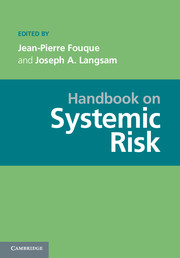Book contents
- Frontmatter
- Contents
- Contributors
- Introduction
- PART I DATA: THE PREREQUISITE FOR MANAGING SYSTEMIC RISK
- PART II STATISTICS AND SYSTEMIC RISK
- PART III MEASURING AND REGULATING SYSTEMIC RISK
- PART IV NETWORKS
- PART V SYSTEMIC RISK ANDMATHEMATICAL FINANCE
- PART VI COUNTERPARTY RISK AND SYSTEMIC RISK
- PART VII ALGORITHMIC TRADING
- PART VIII BEHAVIORAL FINANCE: THE PSYCHOLOGICAL DIMENSION OF SYSTEMIC RISK
- PART IX REGULATION
- PART X COMPUTATIONAL ISSUES AND REQUIREMENTS
- PART XI ACCOUNTING ISSUES
PART V - SYSTEMIC RISK ANDMATHEMATICAL FINANCE
Published online by Cambridge University Press: 05 June 2013
- Frontmatter
- Contents
- Contributors
- Introduction
- PART I DATA: THE PREREQUISITE FOR MANAGING SYSTEMIC RISK
- PART II STATISTICS AND SYSTEMIC RISK
- PART III MEASURING AND REGULATING SYSTEMIC RISK
- PART IV NETWORKS
- PART V SYSTEMIC RISK ANDMATHEMATICAL FINANCE
- PART VI COUNTERPARTY RISK AND SYSTEMIC RISK
- PART VII ALGORITHMIC TRADING
- PART VIII BEHAVIORAL FINANCE: THE PSYCHOLOGICAL DIMENSION OF SYSTEMIC RISK
- PART IX REGULATION
- PART X COMPUTATIONAL ISSUES AND REQUIREMENTS
- PART XI ACCOUNTING ISSUES
Summary
Systemic Risk and Mathematical Finance
The chapters in this part represent a range of approaches to modeling and understanding systemic risk within a mathematical framework. While the subject is still in its infancy, the five chapters here show there are many interesting challenges for mathematicians looking to enter this area.
Rogers and Zaczkowski construct a continuous-time equilibrium model to demonstrate how financial markets affect the ‘real’ economy, particularly through random shocks. Their investigation includes simulating the parts of this economy to show where regulations are needed to control systemic risk.
Grasselli and Ismail also model the economy in an agent-based manner. They focus on interbank lending and with numerical solutions analyze the formation of banking systems and their needs and design for investors. This chapter adapts the tools of network models and cellular automata and shows their importance for the systemic risk problem.
The two chapters by Garnier, Papanicolaou and Yang and by Fouque and Sun, bring large deviation analysis to bear on stochastic models where firms are connected to other firms in a mean-field manner. The models are different, but similar in spirit and aim to capture the small probability with which the interconnectedness can bring down the whole.
The chapter of Choi and Douady takes a dynamical systems approach in which a financial crisis such as the recent one is related to the onset of chaos in the system. Within this framework, they are able to interpret specific crises and the effects of policies such as quantitative easing.
- Type
- Chapter
- Information
- Handbook on Systemic Risk , pp. 369 - 371Publisher: Cambridge University PressPrint publication year: 2013



